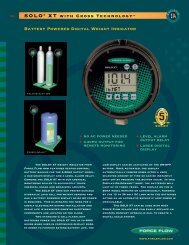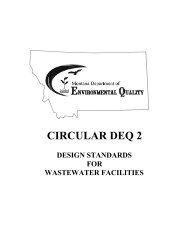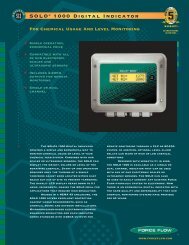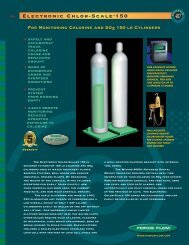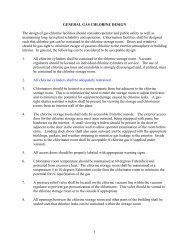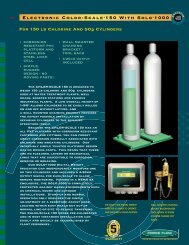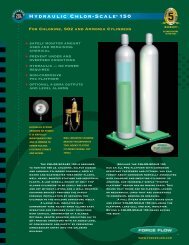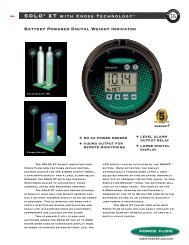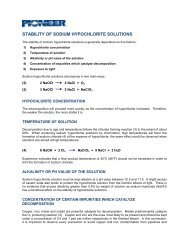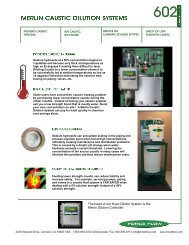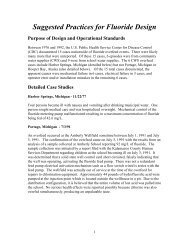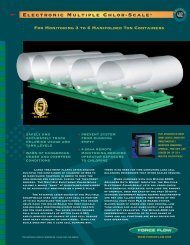Sodium Hypochlorite Handbook - Force Flow
Sodium Hypochlorite Handbook - Force Flow
Sodium Hypochlorite Handbook - Force Flow
You also want an ePaper? Increase the reach of your titles
YUMPU automatically turns print PDFs into web optimized ePapers that Google loves.
4.5.4 FRP PipeStandard FRP available from the typical manufacturer is not successful in sodium hypochloriteapplications. If the pipe is specified and manufactured correctly with the right materials, corrosionbarriers and catalysts systems, FRP can be successful. However, the normal purchaser of pipe andfittings does not have the expertise for these FRP piping systems and they should be avoided.If FRP is the piping system of choice, then location of a qualified FRP piping manufacturer who has theexperience and knowledge to specially fabricate this FRP must be located. The FRP specifications forthe pipe would be very similar to the FRP tanks.4.6 ValvesIn general the valve materials should match the piping system in similar construction for compatibilityand weight considerations. However, the first tank valve on the outlet of the storage tank should be ofvery high quality and a lined steel plug, ball, or butterfly valve should be considered. Gear drives arerecommended in high torque applications to reduce the stress on the nozzle connection.Many different types of valves have been successful in sodium hypochlorite. However, seals shouldtypically be Teflon® and rubber compounds should be Viton® for O-rings and diaphragms.Only flanged or socket welded valves should be used. Do not use threaded. Union style ball ordiaphragm valves provide a leak path past the O-ring seal at the union joint and should be avoidedunless the valve can be easily replaced and downtime is not important.4.7 GasketsWhen low torque is required for non-metallic systems, Viton® or expanded Teflon® (WR Gore) shouldbe used. EPDM is a second choice and will work. The harder Teflon® gaskets should not be used in alow torque application.Expanded Teflon® gaskets may be used for lined pipe systems mating to a titanium flange such aspumps and heat exchangers.Due to cost considerations, plate and frame heat exchangers use EPDM with acceptable results.4.8 InstrumentationThere are many types of instruments used for sodium hypochlorite service. Most plastic or plastic linedmaterials such as PVC, CPVC, Teflon, Tefzel, halar, and other materials will work well for theinstrumentation construction. However, when metal is used in any part of the construction, onlytitanium or tantalum components can be used for contact with the sodium hypochlorite. For pH, ORPand magnetic flow meter electrodes; silver, platinum, gold, tantalum, or titanium are the only materialsacceptable if a metal is required.Since only small amounts of nickel will decompose sodium hypochlorite rapidly, Hastelloy® must neverbe used. Hastelloy® in most corrosion books under sodium hypochlorite may indicate an acceptablecorrosion rate for equipment components. However, the nickel from the Hastelloy® will decompose theproduct. Understand that corrosion tables indicate corrosion rates for the metal in a given product andno consideration is provided for the effect on the product.Since there are many types of instrumentation applications, no attempt is made to review all of them.However, in critical flow applications typically magnetic flow or mass flow instrumentation is used andflow is controlled with very high quality lined steel ball or globe style valves with 50 to 1 turn downratios. These valves are typically air to open, spring to close with 4-20 mA positioners. Electricallydriven control valves are only moderately successful for long service life applications and may notprovide the desired control.



